Working with ContentDistribution.com
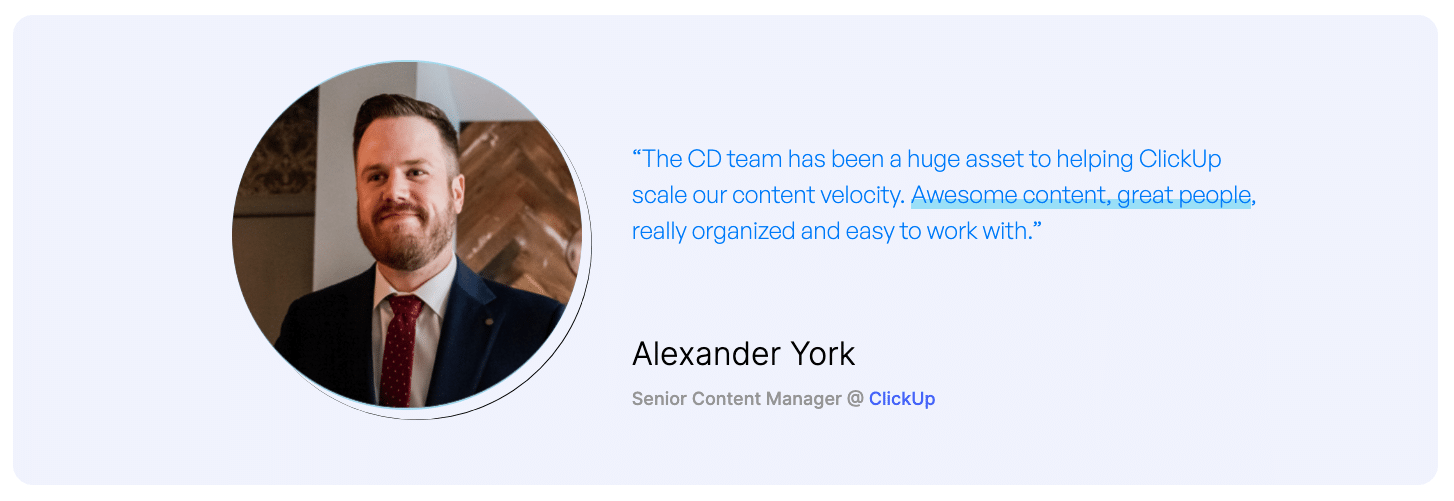
When I started ContentDistribution.com I started at the bottom.
I was a solo-consultant.
Consulting for bootstrapped SaaS founders.
With tiny budgets.
I’m talking $500.
Not $500 per month.
$500.
Five years of consistently winning later…..
And we’ve earned the right to work with ClickUp.
And fintechs w/ $100m in funding.
And FDIC insured banks.
It took us five years of building systems and processes.
Sharpening our axe.
Winning again, and again, and again.
To be able to work with a brand like ClickUp.
And that was the plan all along.
I’m at the bottom.
I need to own the outcome on every project.
Take responsibility for every variable.
Do whatever it takes to influence a positive outcome.
Earn the right to work on more ambitious projects.
And eventually we’ll be so good.
So consistently.
The big boys can’t ignore us.
🥇 Best Content
If you haven’t checked out our free playbooks, open them all in a new tab.
🚀 Adding 100,000 paid customers to an A16z-backed startup
🚀 Driving millions of new users for an EdTech SaaS
🚀 +$1.6m incremental ARR for a subscription Shopify store
And if you have time, check out the rest:
🚀 Maintaining content quality at 100+ pages/month
🚀 0 to 103,000 organics/month (my first SEO project)
🚀 0 to 116,000 organics/month ($30k website flip)
🚀 Baby fat graphs (not big enough for their own case studies)
After you’ve given those a read.
Learn what it’s like to work with ContentDistribution.com
🏆 What the Community is Saying
We’ve spoken at Founders Institute, Search Birmingham, SEO Mastery Summit and on 50+ podcasts.
Join Bojan Maric and Nick Jordan for a workshop on “SEO Basics for Startups” where they’ll be going through the SEO tips and tricks they used to help their clients go from 0 to 100,000+ organic views a month.
To sign up, check out this link 👉https://t.co/ImvlI4U83Q pic.twitter.com/kxNaOb8p8E
— Founder Institute (@founding) January 3, 2023
We’ve appeared on HubSpot, GoDaddy, American Express, Canva, Zapier, and HR.com.
And we’ve had a positive impact on many of our peers.
@nickfromseattle this is the best article I’ve ever read on content production –
— Topline Emails (@toplineemails) July 10, 2022
![]()
🎮 Control of Outcome
The day I started ContentDistribution.com is the day I committed to shutting it down.
It’s not enough that some of my projects go well.
All of them have to go well.
I have too much talent, drive, and momentum to spin my wheels playing a game where my actions don’t have a significant influence on the outcome.
Reminder: Careers are measured in decades.
Not months or years.
— Nick Jordan (@nickfromseattle) September 21, 2023
![]()
The minute I’m playing a game where I don’t believe I can control the outcome, is the minute I’ll take my ball and go play a different game.
So, in the first year of CD, I sandbagged myself.
I took on a few projects and turned down everything else.
I needed to prove to myself that I could influence every campaign I worked on.
And if I couldn’t do it.
I’d do something else.
Probably go back to sales.
And that drive to take ownership of every variable…
Even if it’s literally taking responsibility for the actions of someone else.

Means we’re consistently consistent.
- 0 to 103,000 organics/month
- 0 to 116,000 organics/month
- 0 to 119,000 organics/month
- 0 to 166,000 organics/month
- 0 to 1,500,000 organics/month
- And a ton of smaller wins that aren’t big enough for their own case study
When you take a content-focused approach to SEO, it means that every factor that influences your success is within your control.
The implications of that are huge.
💰 ROI Focused

We have beautiful words.
But our content is a deliverable.
Companies partner with us because our content drives incredible business outcomes.
Showing ROI is the #1 lever we can pull to retain and scale campaigns.
So, we treat SEO as closely to paid media as possible.
We’ll work with you to attribute every dollar generated to the specific pages that we influenced.
Learn how we added nearly 100,000 paid customers to an A16Z-backed startup.
A great SEO campaign for a flower shop in Seattle can influence tens of thousands of dollars in revenue.
A great SEO campaign for AirBNB can influence hundreds of millions of dollars in revenue.
A great SEO campaign for Amazon can influence billions of dollars in revenue.
We built an SEO ROI calculator to forecast various campaign outcomes so we spend our time with the companies that have the most leverage on our team’s superpower.

The TMS, or total monthly search volume, is generated using Ahrefs or SEMRush.
The CTR is calculated using Brian Dean’s CTR study.

The conversion rate, average first-order value, and LTV are calculated using your internal company data.
After you put in realistic numbers, ratchet all of the numbers down:
- Search volume is lower than expected
- Average ranking and CTR is lower than expected
- Conversion rate is lower than expected
- AOV is lower than expected
- LTV is lower than expected
Do you still have a positive ROI of at least 3x?
Great.
That’s a good campaign.
Because when we crush, it means we’re looking at 10x+ ROI.
Use our SEO ROI calculator.
❤️ SaaS DNA
Before starting CD.com, I spent my entire career in early-stage SaaS.
I started in my early twenties when I dropped out of college to ship my first SaaS.
Tonight’s Outfit helped people make better fashion choices.
It was pre-smartphone, a dumb idea, and had zero founder/product fit.
But I shipped.
We shut down Tonight’s Outfit due to lack of traction.
And we shipped again.
It went a bit better.
MLS → Craigslist automation for real estate agents.
Hit $6,000 MRR before imploding.
I was in my mid-twenties, and it was time to get my first real job.
I was a regular attendee at the Seattle Hacker News meetups.
At one of the meetups, I shook hands with the founder of a small enterprise SaaS startup.
He was hiring, and I leveraged my experience into an offer.

Absolutely insane four years.
8 to 200 FTEs bootstrapped.
Just straight printing.

(Source)
After 4 years, I left to re-skill my career in marketing.
BitTitan raised a few rounds, made an acquisition, and was then acquired for a ton of $$$.
I had an ESOP with a 10-year exercise period. (Thanks, Geeman <3.)
This meant even though I left 6 years ago, I still got paid.

But the most valuable takeaway from my four years at BitTitan was the experience:
- Working next to colleagues 20 – 30 years older at the peak of their career
- Learning their best practices and watching how they make decisions
- Operating at a global scale that touched millions of end-users
I negotiated legal contracts against F500 companies.
I designed and PM’d GoDaddy’s implementation of our API.
I product-managed our marketplace integrations with our CTO.
I trained AT&T’s sales team.
And Rackspace’s support team.
You probably view me as the ‘SEO Guy.’
But I identify as a founder, a marketer, and even as a sales guy more than I identify as an SEO.
And this hasn’t changed since starting an SEO agency.
Over the last five years, our team has spent thousands of hours iterating across hundreds of internal processes, and we’ve shipped the two most important SaaS products.
ClusterAi to automate keyword research.
And Workello to hire the top 1% of our job applicants.
The combined stats across both products:
- 7,000+ freemium users
- 650+ paid customers, including brands like Deel, CopyAi, and Forbes
- $400,000+ total revenue
I’m not alone on this journey.
Both products were PM’d by CD’s COO, Bojan Maric.
We also host the #1 content ops community on the internet with 10,000+ members and regular AMAs with marketers from brands like G2, Ramp, Coinbase, SEMRush, and Surfer.

We’ve grown our email list to 13,000+ subscribers.

And our team’s content has reached millions of marketers and founders on LinkedIn.

❌ No backlinks
We don’t build backlinks.
We don’t need to. If we had hit a wall that we couldn’t push past, we would have iterated and experimented, eventually with backlinks. We don’t hit walls. We haven’t had to build backlinks to create the desired outcomes. What we do keeps working.
Content can convert. Content can rank and drive revenue. In the way most backlinks are built, they will usually never send a single referral visitor. Assuming a finite budget, we feel an obligation to steer the budget into the activities with the most measurable ROI.
But the biggest reason we don’t like backlinks?
Relying on backlinks means ceding some of your control over the outcome to the Google Gods.
You tithe money into a black box.
Then you pray to Larry & Sergey.

And if you’re lucky…
The Google Gods bless you with rankings.
As a founder, I would rather compete in poker than craps.
Which game would you rather play?
If your approach to SEO is 100% focused on content.
It means all of the variables that influence your success are on-site and within your control.
Seems like a pretty powerful approach to anything in life.
— Nick Jordan (@nickfromseattle) September 22, 2023
![]()
❌ No Shortcuts
“Play long-term games with long-term people. All returns in life, whether in wealth, relationships, or knowledge, come from compound interest.”
– @naval
— Nick Jordan (@nickfromseattle) September 25, 2023
![]()
95% of the value created by SEO will happen after year one.
Let’s break it down with math.
A hypothetical company has a hypothetical growth rate.
In year one, they grow to 100,000 organics/month.
In year two, they grow to almost 400,000 organics/month.

The 492,554 visitors they generated in year one is 15.2% of the 3,228,117 visitors in year two.
Let me repeat that.
Even if we crush it.
And we grow you to 100,000 organics/month in one year.
10x more value is created after year one than is generated in year one.
My SEO agency publishes hundreds of pages of content each month.
❌ We DON’T use AI. 🤖
👇 Here’s why 👇
Using AI content means introducing a new variable into our SEO campaign:
– That isn’t well understood
– The long term impact isn’t known
– On our most important ranking… pic.twitter.com/mcG18qR5vg
— Nick Jordan (@nickfromseattle) October 12, 2023
![]()
✅ Just Great Content

Many SEOs treat Google like the enemy.
Their strategy is focused on tricking Google into sending them traffic.
We think the most lucrative SEO outcomes are created by aligning with Google.
Our approach to winning big is simple.
For every page of content we publish, our goal is to create more value for the reader than any other page of content Google could show.
Below is a graph of the top websites in the dog niche.
The key metric is column E.
Traffic per page, per month.
It’s calculated by dividing the estimated traffic (Ahrefs) by the total number of pages.
And it measures how efficient an SEO campaign is.

I built Doggypedia.
Despite being a DR9, it generated 100,000+ organics/month.
And on average, 3x more traffic per page of content than Doggypedia’s biggest competitors.
Here is the same graph by average traffic per page per month.
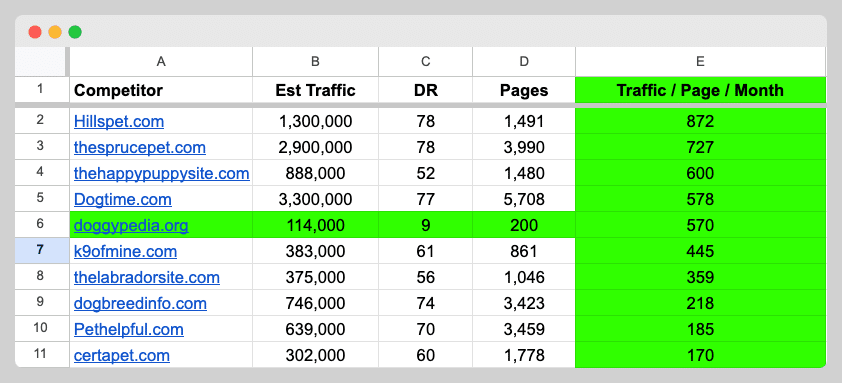
Despite Doggypedia having almost zero backlinks and the other websites being hugely authoritative industry leaders.
Doggypedia outperformed most of the biggest players in the space:
- 3x more traffic than Certapet
- 3x more traffic than Pet Helpful
- 2.5x more traffic per page than Dog Breed Info
- 1.5x more than The Labrador Site
Create more value.
Get more value.
Learn: Get my step-by-step guide to Doggypedia’s SEO campaign.
🔎 Operations
Making Data Public By Default
Most teams collaborate by ‘pulling information’
Here’s what I mean:
- “Hey, what are you working on today?”
- “Can you send me the latest version of the template?”
- “What did Sally say?”
- “Have you done this task yet?
- “Should I do A, B, or C?”
- “Did you see X?”
- “Can you remind me about Y?”
- “How do I do Y?”
- “Did I do this correctly?”
- “Can you check this before I submit it?”
- “Where is the file for Y?”
This works on a small team.
But things start to break when the team grows.
A team of 4 has 6 “lines of communication”. A team of 12 has 66. A team of 50 has 1225 lines of communication. The key to exponential growth is overcoming exponential complexity. pic.twitter.com/6EdTKBODZO
— Daniel Priestley (@DanielPriestley) September 6, 2018
![]()
There are thousands of micro-decisions that are made over the lifespan of an SEO campaign.
On day one as a freelancer, I knew I needed to build a team that could execute as well, or better than I could myself, to meet my goals. So, over the last five years, we’ve spent a lot of time thinking about:
- What context our team needs
- When they need it
- How to deliver it
So they are empowered to make the correct decisions consistently.
Here are some of the areas in which I think we excel and punch above our weight class (company size).
- Making data public by default
- Documentation
- Meeting recaps
- Sprints
- Automated notifications
- Reporting
- Access control
Documentation
Creating a culture of documentation is a lot of work.
But it’s the only way to enable people without your work experiences to execute as good, or better than you can yourself, consistently.
We’ve built a strong culture of documentation that spans almost every organizational function.
And today, we have over 1,000 documents in our knowledge base.
Here are some examples.
Onboarding documentation for new team members

Step-by-step guides to kicking off new projects

Keyword research to develop the content calendar.

Managing sprints.

Editing guidelines.

Everything is documented.
Our culture of documentation enables our team to execute as well or better than I could myself and to be consistent across the areas that require consistency.
Allowing us to drive successful outcomes again and again and again.
Get my step-by-step guide for building a culture of documentation in your organization.
Meeting Recaps

Our team sends out a dozen+ meeting recaps every single week:
- Structured into an easy-to-read format
- Contains a list of discussion points
- Action items called out at the top with owners & due dates
- Sent to all interested parties
Here’s why.
Back in 2012, when I joined BitTitan, here is what I was signing up for:
- Working in an industry I didn’t know existed (Microsoft MSPs)
- Using a technology I didn’t understand (data migration)
- Through a sales channel I didn’t have any experience in (resellers)
- In a role that I wasn’t qualified for (enterprise partnerships)
I spent one month in office.
Then went solo with our CEO on a month-long conference circuit to Vegas, Austin, and Toronto.

Drinking from a firehose is an understatement.
One of my primary survival tactics was taking insane meeting notes.
Every meeting I took, I was typing.
Over time, I became comfortable in my role, but I never stopped taking meeting notes.
On average, it took 9ish months to negotiate each SaaS partnership.
After the deal was signed, it took another 9ish months to go to market and start transacting with their end-customers.
There were half a dozen stakeholders in our company and an equivalent amount, or more, in each partner org.
The only way I could manage a dozen multi-year projects with more than a dozen stakeholders each was with meeting notes.
And I brought that habit to Content Distribution and built a culture of meeting notes here.
Every time two or more people in CD jump on a Zoom call, they send a meeting recap to any relevant team members.
Between client meetings, editing meetings, ops meetings, and PM meetings, our senior staff receive at least a dozen meeting recaps per week.

This enables our team to work async, minimize unproductive meeting time, consume recaps, and jump in with thoughts or questions on their own schedule.
I have never worked in an organization that has done this.
And after five years, I don’t know how organizations that don’t have a culture of meeting recaps get things done.

Get my step-by-step guide to building a culture of meeting notes in your organization.
Sprints
Our team’s work is organized into two-week sprints and tracked in Airtable.

Each record has a status, project, link to a task, person assigned, QA assignee, requestor, due date, notes, and link to SOPs or working documents.
Automated Notifications
One of the easiest areas in which you can implement a “push data” philosophy into your company is with notification channels.
We push data from Airtable & Slite into Slack.
Instead of asking, “Hey, what are you working on?”
Our team leads can check the #notifications-sprints channel.
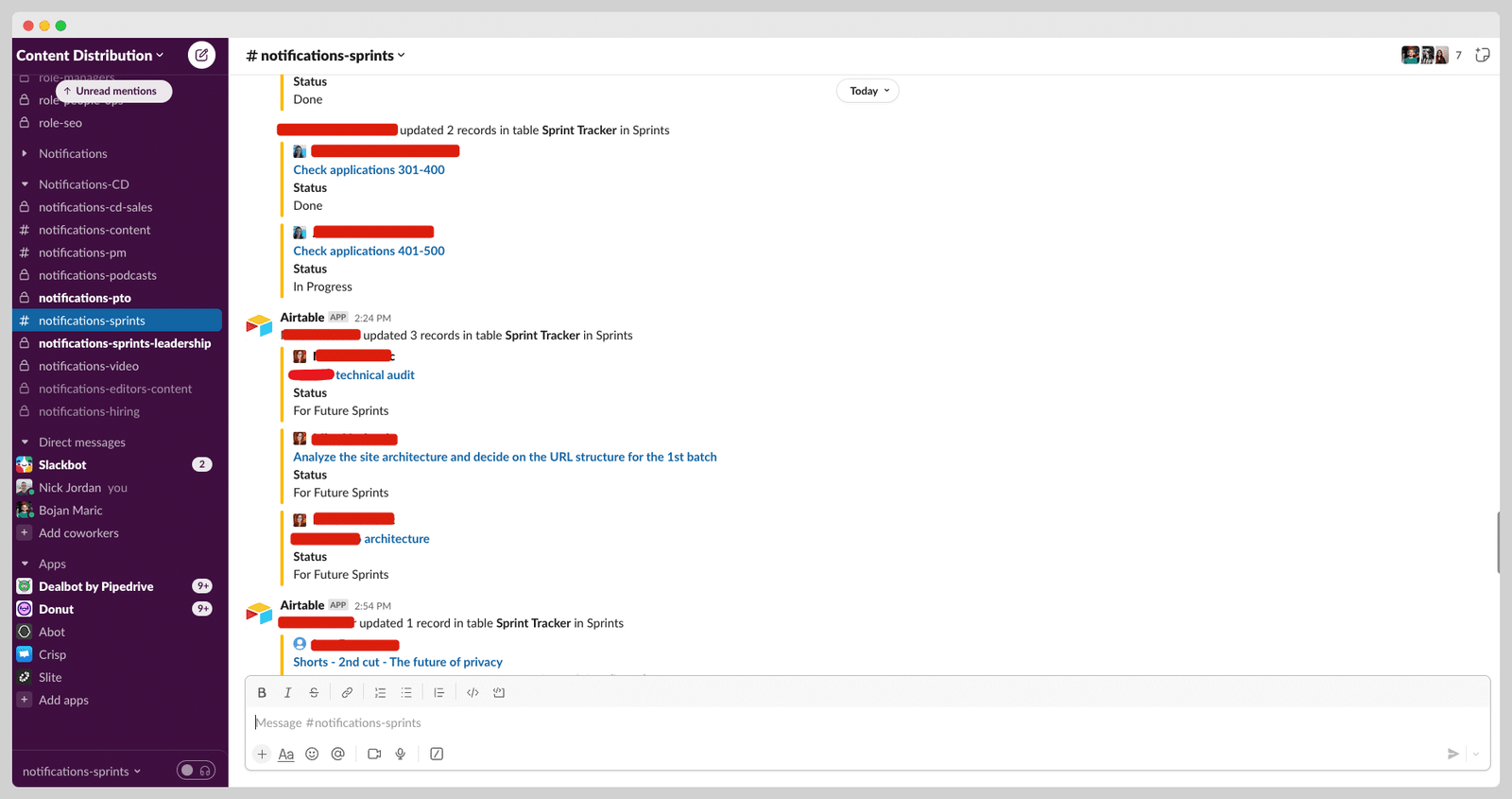
For editors and PM, #notifications-content-calendar.

For editors and managers, #notifications-PTO.

For senior managers, #notifications-hiring

Each notification is hyperlinked.
Anyone in the channel can click on the activity to see metadata like due dates, notes, and links to any working documents.

This cuts down on the “Hey, what are you working on?” significantly.
Reporting
We push the data from Airtable into pre-built Google Data Studio reports that break down our team’s workload.
We can slice the data by all-up, project, and person.

Access Control
CD uses 89 different 3rd party SaaS products for:
- Communication and collaboration
- Managing content production
- Managing our finances
- Hosting and delivering ClusterAi & Workello
- Marketing, sales, and support.
We change and manage access to all apps in this base.

To request access, a team member submits an access request form.
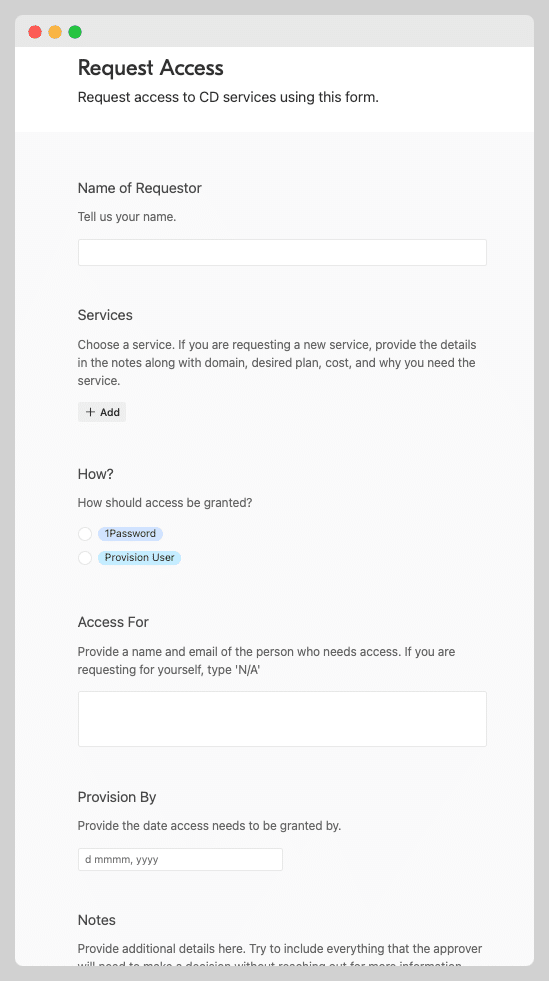
💯 Team
Recruiting
Over the last five years, our team has spent thousands of hours reviewing more than 10,000 applicants.
Because of my belief in two things:
- My success will come from building and enabling a team of people to execute as well or better than I can.
- The #1 decision I’ll make as a founder is who we hire because after that first decision, what happens next is easy, hard, or impossible.
What do those beliefs look like in practice?

- We don’t hire based on portfolio, CV, past employers, work experience, or interview skills.
- We test all of our applicants on the job to be done, whether it’s writing, editing, SEO, video, or VA work.
- Most hiring workflows have a short unpaid test, followed by a longer paid test for applicants who excel.
- We’ll evaluate approximately 300 applicants and 100 tests for each hire we make.

Retention

Once great people join our organization, we do everything we can to keep them happy and motivated.
Between holidays and PTO, our team has 38 days of paid leave per year.
As an American, it feels like everybody is always on holiday.
But as a founder, it means I’ve built a company that doesn’t depend on a single person holding everything together.
Our team can take the time they need when they need it.
And everything continues forward.
Without missing deadlines or superhuman feats of grind.

Other benefits we’re proud of:
- Stipend for private health insurance
- 3 months of paid maternity/paternity leave for team members with 2+ years of tenure
- Overtime compensated with equivalent PTO or cash bonuses
Some benefits we’re thinking about in the future:
- Home office equipment stipend
- Virtual cards for Uber Eats
- Health insurance stipend for our team’s aging parents
📈 KPIs & Accountability
The three big revenue milestones of an SEO campaign are:
- Paying back the monthly SEO spend,
- Paying back the total campaign spend to date (1x ROI)
- Hitting 5x ROI and above,
But it takes time to get there.
I needed to know whether I was on the right track.
So, I developed a set of KPIs that would allow me to know if the campaign was off-track within 60 days.
Today, I use these KPIs to hold my team accountable.
And now, you can use these KPIs to hold your SEO accountable, whether it’s us or someone else.

Over the last several years, I’ve been privileged to work on many very healthy SEO campaigns.
When it comes to KPIs, they all look the same.
A healthy campaign sees growth in the KPIs below most weeks and every single month.
Did we do the good work we said we would do? In the first six weeks of the campaign, we are accountable for being organized, thorough, reliable, and for delivering high-quality strategy, keyword research, documentation, and initial content.
Are impressions increasing? Before we can rank on page 1, we need to rank on page 6. An impression indicates our page has appeared somewhere in the first 10 pages of a search. Impressions should increase 7/10 weeks and increase month-over-month every month.
Are we beginning to receive clicks? At some point, we’ll begin to receive clicks. The number of clicks we receive should increase 7/10 weeks and increase month-over-month every month.
Are visitors beginning to convert? Once traffic is consistently increasing week over week and month over month, we’ll turn our attention to conversions. Is the traffic we’re generating leading to business impact?
Are conversions increasing linearly with traffic? Once we’re consistently generating conversions, is it increasing linearly with increases in traffic?
What we see when we look back at our past campaigns is that after we publish somewhere between 30 to 50 pages, impressions, clicks, and traffic all begin to increase week-over-week, most weeks, and month-over-month, every single month.
An on-track campaign is consistently hitting new ATHs.
My redline is 8 weeks.
If any key KPIs are flat for more than 8 weeks, it’s time to iterate.
95% of flat spots are fixed, and we return to growth by accelerating scoped but not yet implemented tasks. Think site structure, internal linking, or technical SEO like site speed or GSC errors.
👀 Forecasting Growth
We can confidently forecast increasing impressions, clicks, and traffic once we publish the 30th to 50th page of content.
Forecasting specific traffic numbers by specific dates is a lot harder.
- Every page of content we publish can rank for hundreds of keywords
- Each of those keywords has its own unique search volume
- Each of those keywords has its own difficulty
- And all of them move independently of one another
But top it all off.
Before we start the campaign, we don’t even know our content calendar.
Are we publishing the page with 10,000 searches/month in month 1? Or Month 2?
Are we focusing on low-traffic BOFU topics?
We just don’t have enough information in the beginning.
However, once we get some data in the door, we can start making educated guesses.
Here is a VC-backed SaaS we’re working with.

Reading this chart:
- Plots out actual growth vs forecasted growth
- First 4 months spent gathering data
- In month 4, we hit 6,433 visitors and put together our first projections
- We forecasted 30,000 visitors by month 9
- We hit 30,000 visitors in month 7
Additional context:
- Not pictured is the client’s conversion rate
- Based on existing conversion rates, when we hit the forecast of 243,182 visitors in month 16, our campaign is contributing a significant percentage of total growth
- Month-to-month growth rate is less important than maintaining an average growth rate above >30%
- For example, we only grew 17% in month 7, but we grew almost 200% the two months prior
- This means actual traffic is still two months ahead of forecasts
🏃 The Discovery Call
Pre-Call
We have thirty minutes together, and there is a lot to discuss.
I want to learn more about your company, goals, and growth opportunities.
Not explain how we approach SEO.
I’ve spent hundreds of hours formulating my thoughts so you can consume them before we talk.
At your convenience.
Read these.
🚀 Adding 100,000 paid customers to an A16z backed startup
🚀 +$1.6m incremental ARR for a subscription Shopify store
🚀 Publishing 100+ pages/month
🚀 Baby fat graphs (not big enough for their own case studies)
The Call
I have four goals on our discovery calls:
- Learn more about your business and goals
- Sanity check the opportunity using our ROI calculator
- If it passes, discuss our different engagement models
- Answer any questions you have
🔎 Engagement Overview
Full overview of our engagement.
Click the image to see it full-size.
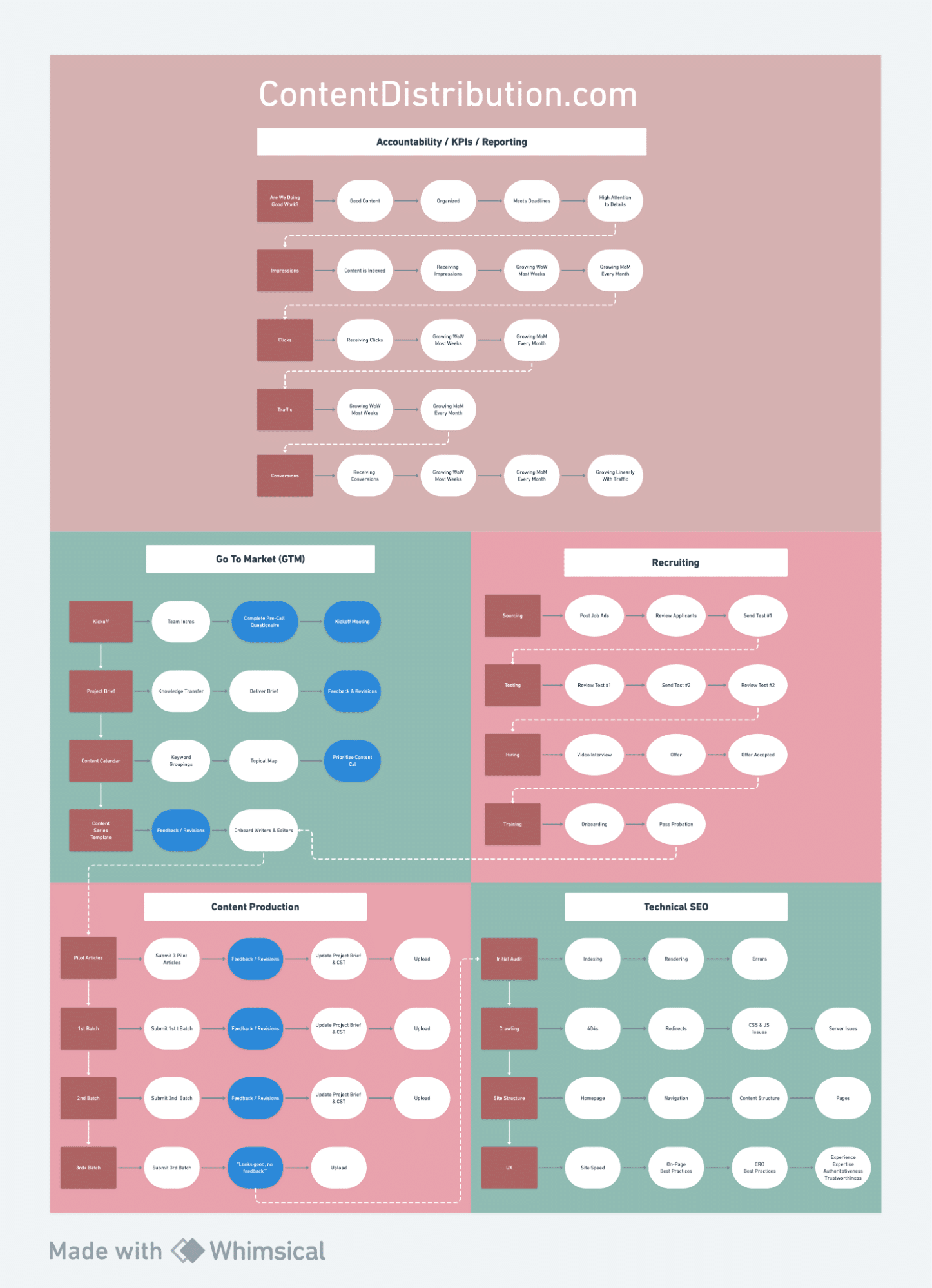
🏃 GTM Sprint

Pre-Kickoff
Half our team has a Master’s degree in English Lit.
The other half are former English teachers.
The reason I tell you this is because structured learning is a core competency.
We have repeatable systems for transferring knowledge from you to us.
These systems have enabled us to create engaging content with the strong thoughts of stakeholders embedded into 200+ content verticals.

Legal, healthcare, medicine, dev ops, open-source software, education, gut biomes, influencer marketing.
We’ve basically done it all.
And the stakeholders we worked with were just as nuanced, and particular about content quality as you are.
Before our kickoff meeting, we’ll send out an introduction email to our team and a link to an intake questionnaire for you to fill out before the meeting.
Kickoff & Knowledge Transfer
We’ll cover 5 things in our kickoff and knowledge transfer meeting.
Meet stakeholders. Our team is small, and our team members working on your project have worked on our agency’s biggest wins. We will also confirm stakeholders on your side for approvals, dev requests, etc.

Knowledge transfer. We’ve consumed your questionnaire answers and we’ll ask any clarifying questions we need.
Timeline. We’ll review our GTM timeline with the next steps and timelines, and provide a link to access it at any time.

Enablement Documentation
In content writing, every word is a liability to get something wrong:
- Messaging
- Positioning
- Tone/voice
- Facts
- Offers
- CTAs
Literally every single word is a liability.
The solution?
The thing that makes it all work?
Documentation.
Everything we learned from your questionnaire answers and knowledge transfer is incorporated into 5 – 10 pages of documentation, internally referred to as, ‘The Project Bible’
This documentation enables us to integrate the strong thoughts you have about your industry, customer, competition, and products into every page of content.

As we receive feedback on publishable content, this project documentation will be kept updated as a ‘rule book’.
So you only have to give us feedback about a particular issue one time.
And you never have to correct us about the same thing twice.
Content Calendar
From a high level the process looks like this:
- Build a list of all of the keywords your audience is using across the funnel
- Group the large list of unstructured keywords into discrete topics
- Prioritize the topics into a content calendar
We’ll take care of #1 and #2, and we’ll work with you on #3.
Everything is kept in Airtable.

Content Series Template
The content series template is another 5–10 pages of enablement documentation, this time hyper-focused on the series of topics we’re creating content on.

Pilot Articles
After the Content Series Template is approved we’ll move onto the pilot articles.
Regardless of how thorough we are in knowledge transfer and enablement documentation, once you see the words in publishable content you’ll have more opinions.
In this stage we will:
- Capture your feedback
- Update and re-submit the pilot articles for review
- Repeat until done
- Update enablement documentation with new learnings
You should expect to never provide feedback on spelling or grammar.
📝 Content Production

After the pilot articles have been finalized we onboard our writers and editors onto the project.
They’ll consume:
- The knowledge transfer call
- The Project Bible
- The Content Series Template
Then they’ll begin writing.
Content goes through a 14-step process before it gets to you.
You’ll spend less and less time on feedback with each round of revisions.
We’ll continue to update our Project Bible & Content Series Template.
At some point between the 5th and 25th page of content, your feedback will turn into ‘Looks great folks, nice work. No additional comments.’
🤖 Tech SEO
SEOs when their technical audit finds two <H1> tags on the Contact Page pic.twitter.com/1YLIsmYJTp
— Nick Jordan (@nickfromseattle) October 2, 2023
![]()
Priority
Technical SEO is only impactful when you have a lot of content.
Spending 10 hours fixing site speed on a 30-page website doesn’t have any leverage.
Spending 10 hours fixing site speed on 500-page websites has huge amounts of leverage.
And enormous leverage on a 10,000-page website.
Chances are your company has closer to 30 pages than 500 pages.
We want to create as much impact as possible before making requests from your development team.
For sites with a low footprint in the SERPs, we will begin tackling technical SEO issues sometime after month three after we’ve ramped up our content production engines.
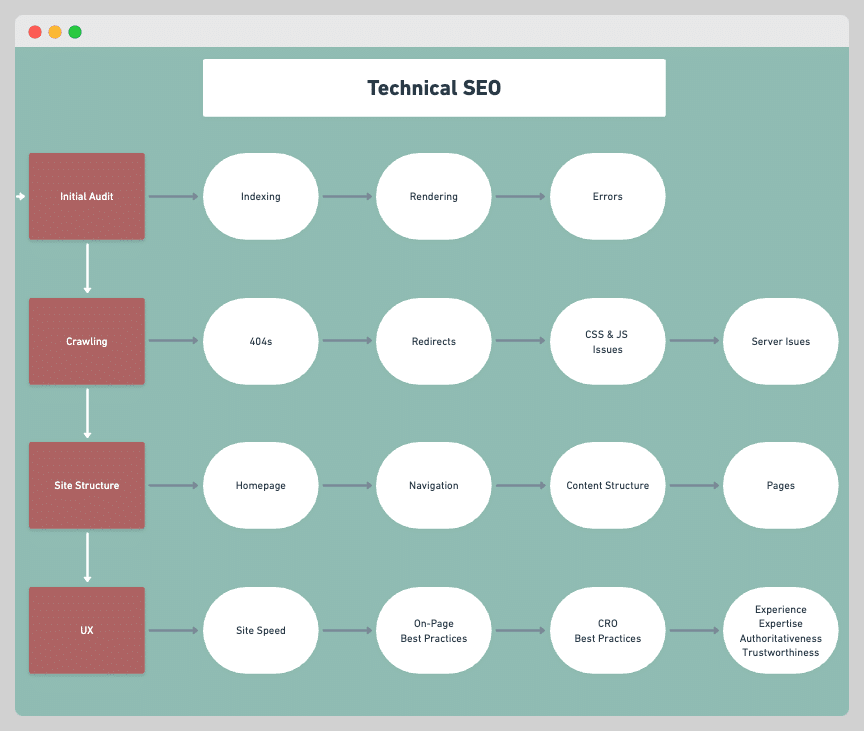
PM → Dev
We will address all technical issues until a developer is required.
Once a developer is required, we will take responsibility for scoping and PMing their workload.
After implementation, we will QA their work to ensure it was implemented correctly.
🫡 Communication
We’ll meet weekly to discuss:
- KPIs
- Action items
- Q&A
Each week you’ll receive a pre-meeting agenda calling out our discussion points. This is your chance to add anything you’d like to the agenda.

After each meeting, you’ll receive a recap with action items for us, and for you.

We’ll provide monthly reports.

And quarterly reports.

Outside of meetings, we’ll communicate via email.
🤝 Working Together

We’re motivated by impact and scale and we want to work with the most ambitious brands on the internet.
Fully Managed SEO
This is for category leaders and future category leaders with huge goals and the budget to execute. We will do everything, you sit back and take the credit.
Content Ops Consulting
For startups on a budget. We will partner with a stakeholder in your organization to build an in-house content team, develop institutional knowledge, and scale up SEO in-house.



